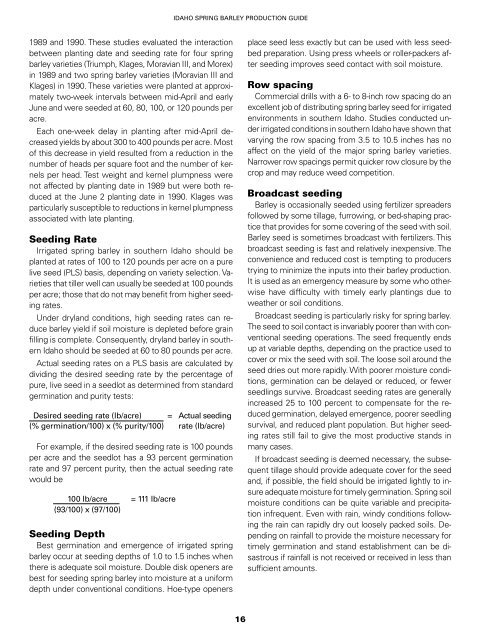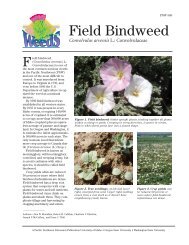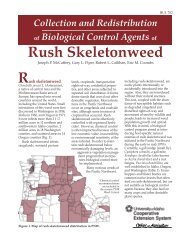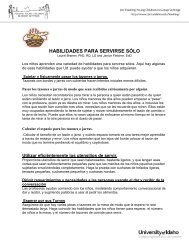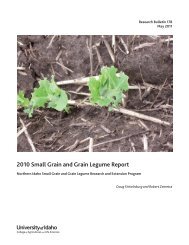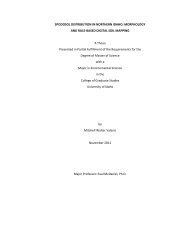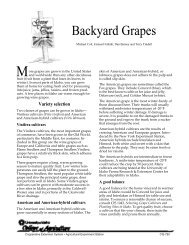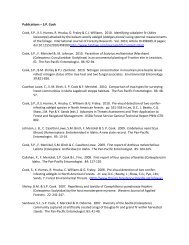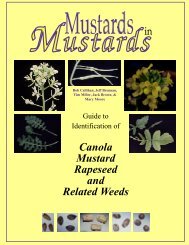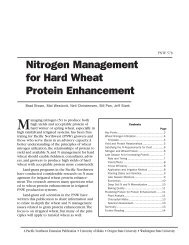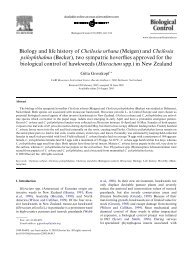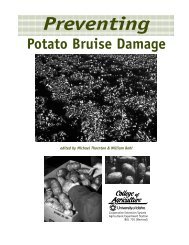Spring Barley Production Guide - College of Agricultural and Life ...
Spring Barley Production Guide - College of Agricultural and Life ...
Spring Barley Production Guide - College of Agricultural and Life ...
You also want an ePaper? Increase the reach of your titles
YUMPU automatically turns print PDFs into web optimized ePapers that Google loves.
1989 <strong>and</strong> 1990. These studies evaluated the interaction<br />
between planting date <strong>and</strong> seeding rate for four spring<br />
barley varieties (Triumph, Klages, Moravian III, <strong>and</strong> Morex)<br />
in 1989 <strong>and</strong> two spring barley varieties (Moravian III <strong>and</strong><br />
Klages) in 1990. These varieties were planted at approximately<br />
two-week intervals between mid-April <strong>and</strong> early<br />
June <strong>and</strong> were seeded at 60, 80, 100, or 120 pounds per<br />
acre.<br />
Each one-week delay in planting after mid-April decreased<br />
yields by about 300 to 400 pounds per acre. Most<br />
<strong>of</strong> this decrease in yield resulted from a reduction in the<br />
number <strong>of</strong> heads per square foot <strong>and</strong> the number <strong>of</strong> kernels<br />
per head. Test weight <strong>and</strong> kernel plumpness were<br />
not affected by planting date in 1989 but were both reduced<br />
at the June 2 planting date in 1990. Klages was<br />
particularly susceptible to reductions in kernel plumpness<br />
associated with late planting.<br />
Seeding Rate<br />
Irrigated spring barley in southern Idaho should be<br />
planted at rates <strong>of</strong> 100 to 120 pounds per acre on a pure<br />
live seed (PLS) basis, depending on variety selection. Varieties<br />
that tiller well can usually be seeded at 100 pounds<br />
per acre; those that do not may benefit from higher seeding<br />
rates.<br />
Under dryl<strong>and</strong> conditions, high seeding rates can reduce<br />
barley yield if soil moisture is depleted before grain<br />
filling is complete. Consequently, dryl<strong>and</strong> barley in southern<br />
Idaho should be seeded at 60 to 80 pounds per acre.<br />
Actual seeding rates on a PLS basis are calculated by<br />
dividing the desired seeding rate by the percentage <strong>of</strong><br />
pure, live seed in a seedlot as determined from st<strong>and</strong>ard<br />
germination <strong>and</strong> purity tests:<br />
Desired seeding rate (lb/acre) = Actual seeding<br />
(% germination/100) x (% purity/100) rate (lb/acre)<br />
For example, if the desired seeding rate is 100 pounds<br />
per acre <strong>and</strong> the seedlot has a 93 percent germination<br />
rate <strong>and</strong> 97 percent purity, then the actual seeding rate<br />
would be<br />
100 lb/acre = 111 lb/acre<br />
(93/100) x (97/100)<br />
Seeding Depth<br />
Best germination <strong>and</strong> emergence <strong>of</strong> irrigated spring<br />
barley occur at seeding depths <strong>of</strong> 1.0 to 1.5 inches when<br />
there is adequate soil moisture. Double disk openers are<br />
best for seeding spring barley into moisture at a uniform<br />
depth under conventional conditions. Hoe-type openers<br />
IDAHO SPRING BARLEY PRODUCTION GUIDE<br />
16<br />
place seed less exactly but can be used with less seedbed<br />
preparation. Using press wheels or roller-packers after<br />
seeding improves seed contact with soil moisture.<br />
Row spacing<br />
Commercial drills with a 6- to 8-inch row spacing do an<br />
excellent job <strong>of</strong> distributing spring barley seed for irrigated<br />
environments in southern Idaho. Studies conducted under<br />
irrigated conditions in southern Idaho have shown that<br />
varying the row spacing from 3.5 to 10.5 inches has no<br />
affect on the yield <strong>of</strong> the major spring barley varieties.<br />
Narrower row spacings permit quicker row closure by the<br />
crop <strong>and</strong> may reduce weed competition.<br />
Broadcast seeding<br />
<strong>Barley</strong> is occasionally seeded using fertilizer spreaders<br />
followed by some tillage, furrowing, or bed-shaping practice<br />
that provides for some covering <strong>of</strong> the seed with soil.<br />
<strong>Barley</strong> seed is sometimes broadcast with fertilizers. This<br />
broadcast seeding is fast <strong>and</strong> relatively inexpensive. The<br />
convenience <strong>and</strong> reduced cost is tempting to producers<br />
trying to minimize the inputs into their barley production.<br />
It is used as an emergency measure by some who otherwise<br />
have difficulty with timely early plantings due to<br />
weather or soil conditions.<br />
Broadcast seeding is particularly risky for spring barley.<br />
The seed to soil contact is invariably poorer than with conventional<br />
seeding operations. The seed frequently ends<br />
up at variable depths, depending on the practice used to<br />
cover or mix the seed with soil. The loose soil around the<br />
seed dries out more rapidly. With poorer moisture conditions,<br />
germination can be delayed or reduced, or fewer<br />
seedlings survive. Broadcast seeding rates are generally<br />
increased 25 to 100 percent to compensate for the reduced<br />
germination, delayed emergence, poorer seedling<br />
survival, <strong>and</strong> reduced plant population. But higher seeding<br />
rates still fail to give the most productive st<strong>and</strong>s in<br />
many cases.<br />
If broadcast seeding is deemed necessary, the subsequent<br />
tillage should provide adequate cover for the seed<br />
<strong>and</strong>, if possible, the field should be irrigated lightly to insure<br />
adequate moisture for timely germination. <strong>Spring</strong> soil<br />
moisture conditions can be quite variable <strong>and</strong> precipitation<br />
infrequent. Even with rain, windy conditions following<br />
the rain can rapidly dry out loosely packed soils. Depending<br />
on rainfall to provide the moisture necessary for<br />
timely germination <strong>and</strong> st<strong>and</strong> establishment can be disastrous<br />
if rainfall is not received or received in less than<br />
sufficient amounts.


